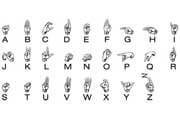March is Deaf History Month, but it actually covers the period of March 13th to April 15th. It's a time to recognize three events - the creation of the first public school for the deaf on April 15, 1817, the founding of Gallaudet University (a college for the deaf) on April 8, 1864, and the Deaf President Now movement (when a deaf man became president of Gallaudet) on March 13, 1988. Now that you're caught up with the history, take a look at what it means to be deaf.
What Is It?
Your ear is made up of three parts - the outer ear, the middle ear and the inner ear. They have to work together in order for you to hear properly, but if there's a problem with one or more parts of your ear, you may not be able to hear. That's what deafness is - partial or complete hearing loss.
What Causes It?
Deafness can be passed down in families or caused by long-term exposure to noise from living near airports and freeways or listening to really loud music through your headphones. You can also become deaf from ear infections or diseases like the measles, mumps or meningitis, that damage the ear.
Different Types
There are two main types of deafness. The most common type is conductive deafness, which is a form of partial hearing loss. It affects the outer and middle ears and is usually temporary. The other type is sensori-neural deafness, which is permanent. It's caused by a problem in the inner ear, usually in the cochlea (the part of your ear that's filled with liquid and lined with tiny hairs).
Ways of Communicating
Hearing-impaired people communicate by speechreading (reading a person's lips) and using Sign Language, which is a language of hand movements. Hearing aids, which are tiny electronic devices that fit in the ear, can be worn to help you hear better, but if those don't work, a cochlear implant can be surgically implanted. It works by turning sounds into electrical signals that directly stimulate the auditory nerves.
Did U Know?
- About three in 1,000 babies are born with hearing impairment, making it one of the most common birth defects.
- Like spoken language, different regions of the world use different forms of sign language.
- The huddle formation used by football teams originated at Gallaudet University to prevent other schools from reading their sign language.
- William Hoy, a deaf center-fielder for the Cincinnati Reds, invented the hand signals for balls and strikes in baseball.
- Ludwig van Beethoven lost his hearing in his twenties, but continued to compose what many believe is some of the greatest music ever written!
Related Stories:
- Working With the Deaf
- History of Sign Language
- Dealing With Dyslexia
- More Facts About Your Health and Body!

































